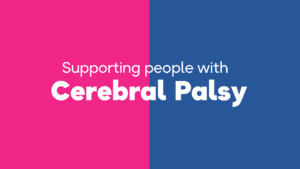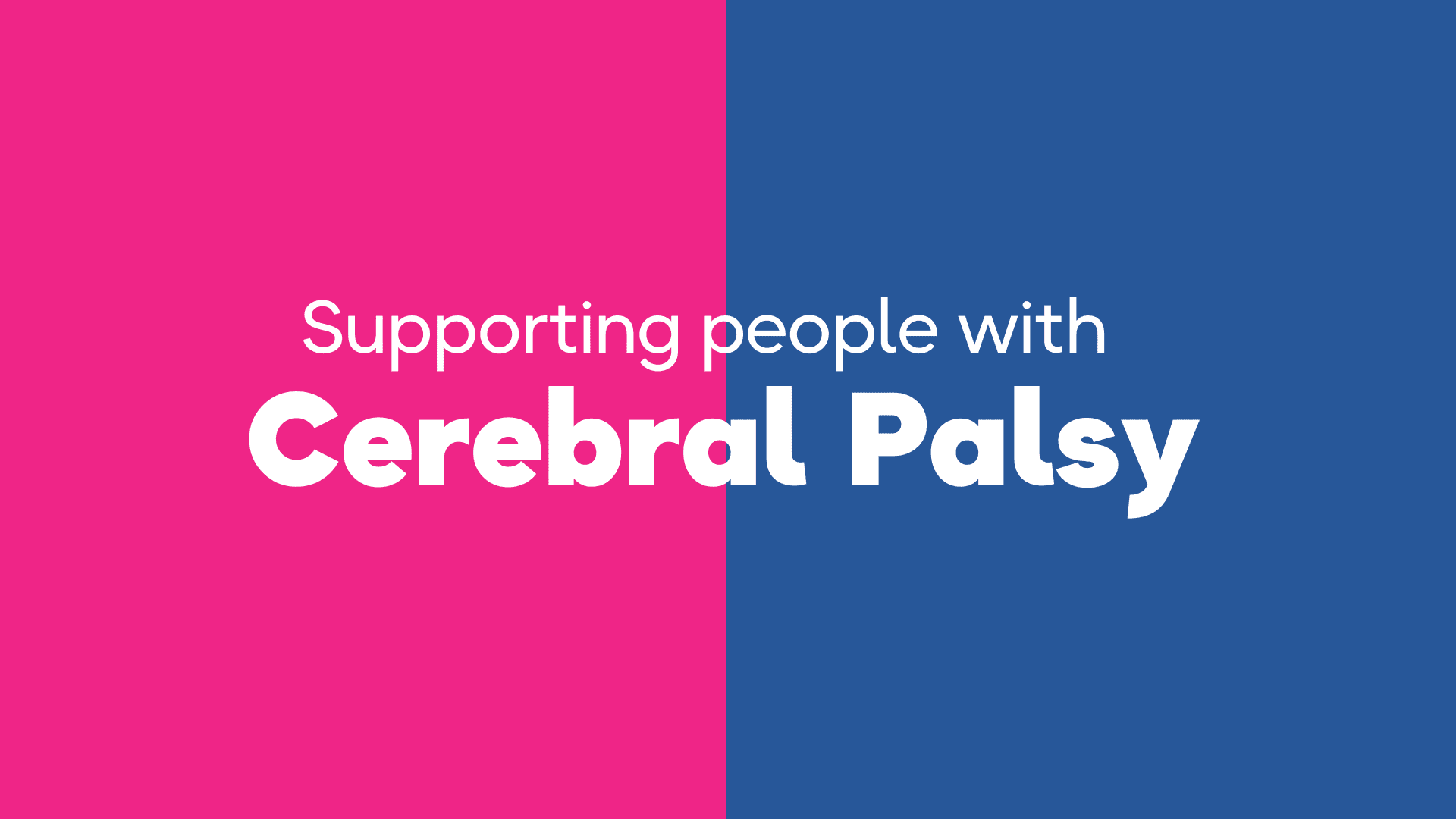
What is Cerebral Palsy?
Cerebral Palsy is a group of disorders that affect a person’s ability to move and maintain balance and posture. Cerebral means having to do with the brain. Palsy means weakness or problems with using muscles and some people may require support.
Cerebral Palsy is a lifelong physical disability. The parts of the body affected, the level of severity, and combination of symptoms can differ for each person. It can affect one side of the body, the whole body, or specific limbs.
There are different types of Cerebral Palsy, so it is important that if you are caring for someone with the condition, you are aware of which type affects them.
What are the causes of Cerebral Palsy?
Cerebral Palsy is caused by a problem with the brain that happens before, during, or soon after birth. The brain can either be damaged or not developed normally, although the exact cause is not always clear.
Cerebral Palsy is usually caused by a problem that affects the development of a baby’s brain while it is growing in the womb. These problems could include damage to part of the brain called the white matter, possibly as a result of a reduced blood or oxygen supply – this is known as periventricular leukomalacia. It could be an infection caught during pregnancy, such as cytomegalovirus or rubella. The baby could have had a stroke, where there is bleeding in the baby’s brain or the blood supply to the brain is cut off, or it could be an injury to the unborn baby’s head.
Cerebral Palsy can also sometimes be caused by damage to a baby’s brain during or shortly after birth. It could be due to the brain temporarily not getting enough oxygen during a difficult birth, an infection of the brain, a serious head injury, choking or nearly drowning resulting in the brain not getting enough oxygen, a stroke, or a very low blood sugar level.
Risk Factors
Some things can increase a person’s risk of being born with cerebral palsy. Risk factors include being born prematurely, having a low birthweight, being part of a multiple birth (twins or triplets), or the mother smoking, drinking a lot of alcohol, or taking drugs during pregnancy.
If a baby has an increased risk of developing the condition, a doctor may recommend having regular checkups to look for symptoms during the first 2 years of their life.
Symptoms and Other Complications
Symptoms of Cerebral Palsy are not usually obvious straight after birth, but more noticeable from an early age.
Possible signs in children include delays in development milestones, weak limbs, being fidgety or clumsy, random or uncontrolled movements, muscle spasms, or walking on tiptoes.
People living with Cerebral Palsy are prone to other complications, including feeding or swallowing problems, communication or speech difficulties, seizures or fits, scoliosis, urinary incontinence, hearing loss, or a learning disability.
Treatments
While there is no current cure for Cerebral Palsy, there are treatment options available to help people with the condition be as active and independent as possible.
Available treatment options include:
- This includes exercises to help maintain and improve movement. Physiotherapy is one of the most important treatments for people with Cerebral Palsy. The main goal of this treatment is to encourage movement, increase strength and stop muscles becoming weak, and stop muscles shortening and losing their range of movement – which can be painful and affect how bones and muscles grow.
- Speech and Language Therapy. This can help people who struggle with communication. A Speech and Language Therapist can provide exercises to help practise speech, or teach an alternative method of communication, such as sign language or using pictures.
- Occupational Therapy. This involves a therapist identifying problems that a person has carrying out everyday tasks. They can advise about the best way to do activities that involve complex movements, such as going to the toilet or getting dressed. They can also advise adults with Cerebral Palsy on independent living; this can include housing, getting a job, benefits, and technology like computers and gadgets that can make it easier to do things.
- Examples of medication that people with Cerebral Palsy may be prescribed include medicines for muscle stiffness such as diazepam or baclofen, botulinum toxin injections that relax certain muscles for a few months at a time, painkillers for discomfort or pain, and medicines to reduce constipation or drooling.
- Some people with Cerebral Palsy may need surgery to help with movement difficulties or other problems. Surgery can be carried out to restore movements to parts of the body if they are restricted by a tight muscle or piece of connective tissue, repair a hip joint that has popped out – people with Cerebral Palsy can be prone to dislocation of their hips, or to make walking easier by reducing stiffness in the legs.
How can I support someone with Cerebral Palsy?
Because there are different types, people’s support needs will differ and also may change with time.
Caring for someone with Cerebral Palsy requires a comprehensive approach. Besides helping the individual perform daily tasks, it is imperative to prepare for symptoms associated with Cerebral Palsy.
If you are supporting someone living with Cerebral Palsy, there are many ways in which you can support them to live a fulfilling life.
Assisting with daily activities. Some adults with Cerebral Palsy will struggle to complete ordinary tasks on their own, such as getting dressed, eating, or brushing their teeth. You can support them by assisting them with these tasks, like making them lunch or helping them choose an outfit.
Helping to administer medications. Some adults with Cerebral Palsy will need certain medications to help alleviate their symptoms and other related medical issues. As a caregiver, you may need to assist with administering these medications depending on the individual’s symptoms and their severity.
Encouraging them to socialise. Socialisation presents numerous benefits for people with Cerebral Palsy, such as keeping their social abilities, emotional health, and overall wellbeing intact. You should encourage the individual to socialise by taking them to the park, joining support groups, or doing fun activities outside of their home.
Monitor their physical and emotional health. Adults with Cerebral Palsy may be at risk of additional health issues. Therefore, as their caregiver, you will need to monitor their physical and emotional health. Doing this could prove critical in some situations, such as if the individual is in a medical emergency.
Do engaging activities. Adults may have lived with their condition for some time, so they will have a good idea of what they are capable of doing. Keeping this in mind, you can still get them involved in some activities that aren’t outside of their comfort zone. For example, you could cook, bake, paint, or play an instrument with the individual which can advance their motor skills.
Reference: NHS
For further information on Cerebral Palsy, you can visit: www.nhs.uk/conditions/cerebral-palsy
https://www.scope.org.uk/advice-and-support/cerebral-palsy-introduction/ rel=“nofollow”
_________
Do you have Cerebral Palsy and looking for support? Contact Smeaton Healthcare today, we’re more than just a care agency – we’re a family. Our values are not just words on paper; they’re the guiding principles that shape everything we do.
With a strong emphasis on integrity, compassion, and excellence, our family-oriented approach ensures that every member of our team feels valued, supported, and empowered to deliver the highest standard of care to those we support.
We believe that by putting our values at the core of our operations, we create a culture where every individual – whether they’re a member of our team or our customer – is treated with dignity, respect, and kindness.
Hello@smeatonhealthcare.co.uk | 0330 165 8880



